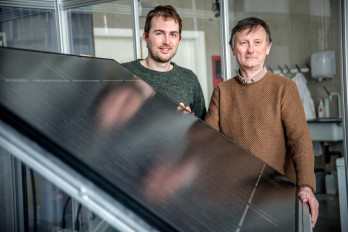Hydrogen Panels
Last year, professor Johan Martens of the KU Leuven and his fellow researchers Tom Bosserez and Jan Rongé made headlines all over the world. This hydrogen panel converts sunlight and water vapour from the air directly into hydrogen gas.

Hydrogen gas is considered one of the sustainable energy carriers of the future, mainly if it is produced from green energy sources. It can be stored and transported. Green hydrogen will, without a doubt, be intensively used in industrial processes. The use of green hydrogen will significantly reduce CO2 emissions.
The researchers do not use a normal electrolyser for their hydrogen panel, but they compactly combine the absorption of the water from the air, splitting water and capturing sunlight with electricity production. It, therefore, looks like a solar panel, but produces green hydrogen and is thus called “hydrogen panel”.

“We get a return of up to 15% which means that 15% of the solar energy that the panel receives, is converted into chemical energy stored in hydrogen gas”, explains prof.Martens.
Flux50 played a role in the further development of the hydrogen panel by supporting the first demonstration in a home in interdisciplinary cooperative research project ROLECS. A panel of 1.6 meters by 1 meter was placed to produce hydrogen gas during the summer. That fuel could then be used for heating and electricity production in the winter. The house also has solar panels to generate electricity and a solar water heater to produce hot water. The three techniques together should be sufficient on paper to provide sufficient energy all year round.

Flux50, alongside Catalisti, also follows the further steps towards industrialisation in the ‘later stage innovation’ project HyPPr in the context of the innovation programme ‘Moonshot’. The HyPPr project aims to create a pilot line & living lab that supports the design, upscaling of production and the integration of innovative hydrogen panels. Both projects are financially supported by VLAIO.
